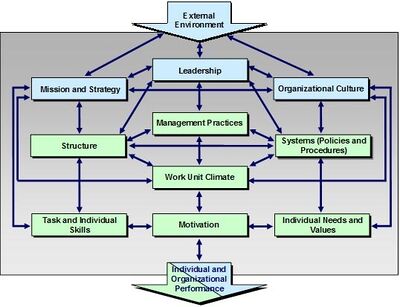Burke-Litwin Model of Organizational Performance and Change
Burke-Litwin is a system science model that describes the linkages among the key factors that affect performance, and determine how change occurs in an organization. Through the use of this model system, engineers obtain data on what organizational factors to change and why. Higher level factors (blue boxes) have greater weight in effecting organizational change; a change in any variable will ultimately affect every other variable. The Figure below, Burke-Litwin Model of Organizational Performance and Change, depicts the system science approach:
This Performance and Change Model, developed in 1992 by two organizational change consultants, W. Warmer Burke and George H. Litwin, is a tool used to understand an organization's component parts and how they relate to each other in a time of change. A common reason for a change initiative failing is all areas of the organization affected by the change are not accounted for. Therefore, using this model can reveal what areas of the business are affected and how they are interrelated. The model also demonstrates the hierarchy of factors within an organization and hence the flow of influence from one factor to the next. The model is an example of ‘open systems theory’, which suggests change comes from external influences. The authors describe the model as a mechanism that portrays “…the primary variables that need to be considered in any attempt to predict and explain the total behavior output of an organization, the most important interactions between these variables, and how they affect change”. There are four groups of elements within an organization; the external environment, transformational factors, transactional factors and performance. Each group then contains various elements of the organization. The diagram above demonstrates which elements belong in which group, how they interact with each other and the overall hierarchy of an organization.[1]
Burke-Litwin Model - The Three Levels of Changes in the Organization
Transformational Change
It is caused by the environment outside. It has a direct as well as effective impact on leadership and organizational culture, mission, and strategy.
Transformational change is defined as a 2nd order. Frame-breaking changes that completely change your current operating structure.
These changes lead to huge changes in processes, people, and usually on a large scale of technology.
When one acquits you adopt these changes. After this, you are unable to return your mind. Because of which you are not able to go back to the old way.
Pros and Cons of Burke-Litwin Model[2]
Advantages of Burke Litwin Model of Change.
- This is a comprehensive model covers all the important factors into account to explain why change is happening, what is driving change and helps in formulating change strategy.
- This model explains factors of change on the basis of cause and effect relationship which helps to have complete understanding about organizational change.
- This model explains the meaning and distinction between transformational and transactional level of change leadership in an organization.
Limitations and Disadvantages of Burke Litwin Model of Change
- The critics of this model are of the view that over simplification of different factors of change results into producing sub factors which actually makes it a more complex model.
- This model only focuses on what drives change and fail to explain how to implement change.
- It puts external environment factors on the top which drives change which is not always the case. There are internal factor as powerful factors which lead to organizational change.
- ↑ Explaining the Burke-Litwin Model Accipio
- ↑ Pros and Cons of Burke-Litwin Model Change Management Insight

